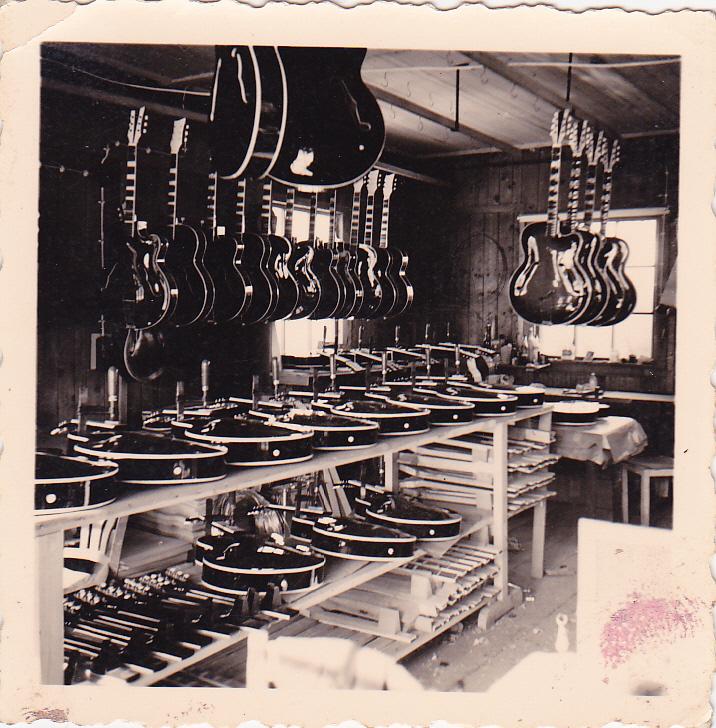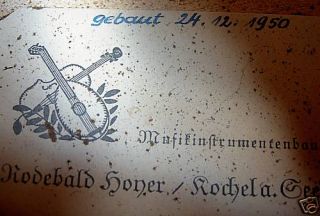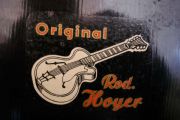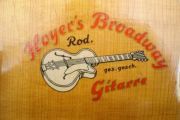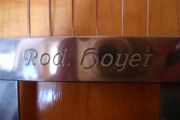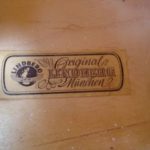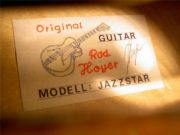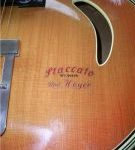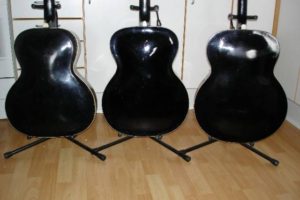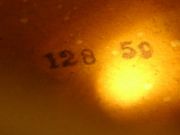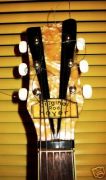Hoyer, Rodebald
Rodebald Hoyer ( 1909-1964) was expelled from Schönbach in Egerland ( now czech ) and settled in Kochel am See in Southern Bavaria, where he opened his shop. As the production got bigger he hired more people. In the most busy days he had 15- 20 emplyees. The production was very rational and most of the wworkers produced parts only, while Rodebald himself along with his foreman was in the end of the production. From around 1957-58 Rodebald and his right hand Haberfellner were the only ones that could build a complete guitar from scratch. The two of theme worked on and developed the highends and showguitars for exhibitions etc…When Rodebald died in 1964 Haberfellner and Rodebalds wife Anni ran the business untill mid 1966 where they closed Down. More historical info by Stefan Lob below…scroll Down a bit, please 😉
Rodebald Hoyer (1909-1964) blev i 1947 fordrevet fra Schönbach i Egerland ( nuværende Tjekkiet ) og slog sig ned i Kochel am See, hvor han åbnede sit guitarværksted. Efterhånden som produktionen blev større ansatte han flere arbejdere, 15 – 20 var der, da der var flest . Produktionen var meget rationelt anlagt og de fleste ansatte arbejdede med fremstilling af enkeltdele, mens Rodebald selv og hans formand stod i produktionens slutled. Fra ca. 1957-58 og til slutningen var formanden Haberfellner og Rodebald i øvrigt de eneste ,der kunne bygge en guitar “fra bunden”. De to udviklede sammen prototyper og showmodeller til messer osv. Jeg går ud fra at de også byggede topmodellerne fra start til slut . Efter Rodebalds død i starten af 1964 fortsatte hans kone Anni virksomheden til midt i 1966.
Selv om de fleste af Rodebalds guitarer ikke bar nogen form for labels, er de alligevel ret lette at genkende, når man først har lært det. Af typiske kendetegn kan nævnes det langstrakte svagt vinklede hoved med den meget brede saddel. Kroppens form er ret ofte den samme , – en stor 17 tommer bred krop med eller uden cutaway og en typisk form omkring cutaway ( hvis det er der!). Der findes fem former for f-huller , flammeformede huller (kun hos Rod. Hoyer) og todelte lydhuller, som hos bl.a Lang. Guitarerne er ofte daterede med et stempel inde i kroppen.
Rodebald leverede mange guitarer til Musikhaus Lindberg, München , som undertiden satte deres egne labels i instrumenterne og anvendte egne modelbetegnelser. Rod selv synes kun at have anvendt få modelbetegnelser ( Staccato, Broadway, Jazzstar, Solist ), men brugen af disse ( især Broadway navnet ) er tilsyneladende ikke helt konsekvent . Der findes også Rodebald Hoyer guitarer, der bærer navnet Alva,- disse har ofte en helt typisk hals, men en mindre krop. Man kan også finde Rod. Hoyers guitarer med labels fra Herwetone, Johann Hornsteiner og Korri. Rod. var en meget dygtig og opfindsom bygger. Blandt andet eksperimenterede han med et resonatorsystem i nogle af sine modeller.
More info here: http://schlaggitarren.de/archtop/rodebald-hoyer
Rodebald Hoyer Extra.
In 2009 I worked on an article about Rod. Hoyer in cooperation with Stefan Lob from Germany who runs the “bible” of german archtop guitars www.schlaggitarren.de
The result of our work can be seen here in german language :
http://www.schlaggitarren.de/home.php?text=hersteller&kenn=75
Rodebald Hoyer.
Article written by Stefan Lob with help from information from Martin Haberfellner
Identification guide by Kield “Lacquercracks”
History by Stefan Lob.
Rodebald ( Rod. ) Hoyer was born dec. 5 , 1909 in Schönbach, Egerland ( now Czech ) . He learnt the trade of manufacturing stringed instruments by his father Anton Hoyer III. In Schönbach there were many dublicate names, so nicknames were very common. Anton was known as Neuburger-Toni. Since Hoyer was a very common name in Egerland there is no reason to think that they had family relations to the Hoyers ( Arnold Hoyers family) who settled in Tennenlohe bei Erlangen. Anton Hoyer was also born in Schönbach in 1880 and got his certificate in 1905. Anton and his son Rodebald built mostly mandolins, tamburizzas, balalaikas and guitars. They were both forced to leave Schönbach in 1947 and settled in Kochel am See, Bavaria.
Rodebald opened his first workshop here on december 15, 1948 and was registered as craftsman on january 8, 1949. The first workshop was located at Bergfeldweg 270. In 1950 Anton died, and some time later Rodebald moved the workshop to Friedzaunweg 2. According to article in ” Feurwehr Kochel am See” this place was totally destroyed by fire on october 7, 1957. After the fire the company moved to Von-Aufsessweg 1. Karl Haberfellner owned this place and until around 1957 he had a wheelwright, as well as building- and furniture manufactory there. In the beginning Hoyer leased the buildings and later on he bought them. Just before his death in 1964 he made some modernizing and new building. After his death his wife , Anna Hoyer, continued the business untill june 1, 1966. Haberfellner who had worked with Hoyer, then became the manager, mainly because he was the only one with a “meister” title.
Hoyer was the only skilled instrument maker in the company. Karl Haberfellner was an experienced master of woodworking. His father had been a musician and instrument maker and Karl himself played both violin and guitar. During his time at Hoyers workshop he acquired the necessary knowledge and skills to build a guitar. In addition to Hoyer he was the only one who could build a guitar from start to finish. Rod. put a lot of instruments on the market in a relatively short periode. He produced very efficiently and the emplyees were only producing parts like fretboards, necks and so on. In the best of times he had employed 15- 20 workers. One of the employees was Rudolf Fuchs who worked as a semi-skilled helper for Hoyer. His work was largely focused on polishing instruments, stringing and preparing instruments for shipping. Each person had a specific task and Haberfellner and Hoyer were responsible for the final production of the guitars and developed new models and prototypes/ showmodels for trade shows. They mainly made archtops, but also simple classic guitars for students and “wandergitarren”. They also worked on solidbody guitars. Martin Haberfellner remembers that his father worked on an “OP-ART” guitar. OP-Art is connected to the artform Optical Art, which is an artform that tries to play with the visual perception of the viewer. With the help from geometric and abstract shapes and pattern, figures and colors optical illusions are created, which gives the viewer the impression of flickerings and movements and so on. In the early sixties, inspired from newspaper reports, Haberfellner experimented with prototypes of OP-ART guitars. They were solidbody guitars with black and white patterns, consisting of squares, diamonds, waves etc, on the body. The patterns were painted but did also consist of inlaid perloid. Martin Habefellner still remembers how his father worked on this unusual guitar on the kitchentable at home. He does not believe it was ever put in production.
Those who wants to see how a serial produced OP-ART guitar looks, please have a look at the article about Wolfgang Hüttl. Hüttl did put an OP-ART guitar into the market.
Haberfellner was a skilled and creative artisan who loved to work with inlays and new designs.
The main customer for Rod. Hoyer guitars was the Munich based trader “Musikhaus Lindberg” who sometimes put their own labels in the guitars and renamed them. Learn more about this in the identification guide below.
Identification guide by Lacquercracks.
©Stefan Lob and Lacquercracks
If they have labels its not so difficult ! There are many different labels and decals, most of them shown here, but most of the guitars from his workshop are not labeled at all. Many guitars are labeled with the Lindberg label, but that does not necessarily means that they are made by Rodebald. There are some very caracteristic things that shows if they are Rodebalds.,- like : the wide flat stringspacer ( nut) and the somewhat elongated headshape is very unique for rods. ( see photos of heads below).
The shape of the cutaways are also very caracteristic. Notice the shape on the photos in the modeldescriptions below.
Most of the guitars have the same bodyshape (with or without cutaway) as the one at the right on the pic below:
This is the “normal” size and shape (with or without cutaway) of more than 90 percent of the Rodebald Hoyers I have seen.
Here are the meassures:
Lower bout: c.43 cm
Upper bout: c.32,5 cm
Waist: c.27,5
Length: c.53 cm
Depth: c.7,5 – 8 cm
The one in the middle ( early to mid fifties ) : lower bout: c40,5 cm – upper bout: c.31 cm- waist: c.25 cm-Length: c.51 cm- depth: c.10-10,5 cm
The one at the left ( dated 24.dec.1950) : lower bout: c.41 cm – upper bout: c.28,5 cm – waist: c.23,5 cm – length: c.49,5 cm – depth: c. 8-9 cm
There are also a few bodies with other sizes , as thinlines and smaller bodied guitars ( some of them labeled Alva), but they are not very common.
How to date Rodebald Hoyers and Rodebald Hoyer made Lindbergs.
Inkstamps:
Most of the guitars are quite easy to date, because they have day, month and year written inside with inkstamps. The stamps can be found on the back just under the bridge, quite easy to see through the soundholes by using a flashlight. The guitars are normally stamped twice, so the stamps can be seen from both soundholes. The format can be 17 964 meaning september 17 1964 or 154 61 meaning april 15 1961 and so on.
But not all guitars have stamps inside, and then we have to date them by other methods. Looking at the guitars construction and decorations and colors can give very useful hints to their age. Head decorations gives very good clues.
Heads showing timeline:
It is possible to get a pretty good idea of the guitars age just by looking at their heads, and in combination with other things like the shape of the holes , we can sometimes get a very good idea of production year. More readings and it will be even easier. Please notice that some of these “clues” are based on very few readings.
These are two of the older heads, probably from 1949-1953. We have no inkstamp readings of this type.
This is also supposed to be a really old one from around 1949 to 1955.
We have no inkstamp readings from this type.
©Stefan Lob
This head has the same shape as the older ones.
Its not a common type, and this is the only one I have seen.
Its dated 1956.
© Ol’ Fret

Here we have a typical mid fifties Lindberg head used on most models from low- to highend models.
It shows six white stripes on black background and black stringspacer.
Probably used from early fifties untill around 1957 or 1958.
We have only 2 readings of this type and they are both from 1955.
© Lacquercracks
 Here we have five black stripes on white background. This head follows the one above.
Here we have five black stripes on white background. This head follows the one above.
We have two readings from 1958 , – both with white stringspacer.
© Lacquercracks
 By the end of the fifties the number of stripes was reduced to three.
By the end of the fifties the number of stripes was reduced to three.
Development goes towards simplicity. Only one reading here from 1959.
© Lacquercracks

In the late fifties the asymmetric heads with the red and white colors became kind of standard, because the black and white striped heads dissappeared. But it seems that red and white colored heads did exist also in the early years. I have seen a few good examples of this.
We have several readings of asymmetric heads like this from 1958 to 1965.
© Lacquercracks

This is the typical and most known jazzstar head.
We have quite a lot of readings of these.
Guitars with this kind of head are made from around 1959 to 1962 it seems.
Most of them have a five piece neck.
©Stefan Lob

Again an example of development towards simplicity,
because from 1962 and untill the end the jazzstar-types has no overlay at all.
But they do have 9 piece necks instead of five piece necks. No rules without exceptions.
© Lacquercracks

Here is an example of a one-colored head in white perloid.
Quite rare and I have no idea about the modelname,
but this one is from the sixties for sure.
© Lacquercracks

This one-color head belongs to a Lindberg Rumba ( later called Swing ),
and they had this kind of head in the late fifties and maybe into the sixties.
We have more readings of this type from 1956 to 1960.
© Lacquercracks
 The asymmetric heads with no overlays belongs normally to the low-end models or the
The asymmetric heads with no overlays belongs normally to the low-end models or the
late models. This one is from 1964.
© Lacquercracks

This is a rare headoverlay on a jazzstartype .
© Stefan Lob
This is a rare headoverlay on a Broadway/Staccato type.
© Stefan Lob

This is a head from a Staccato/Broadway.
No overlay but You can see that the neck is made from around fifty pieces.
Time is around 1960 give or take a year or two.
© Stefan Lob

This is from a Broadway, only with a little fewer pieces in the neck.
Rule of development strikes !
We are now around 1961 .
© Lacquercracks

Here we have another Broadway, and rules of development has striked again,
because we now have a 15- piece neck.
Now we are in 1961-1963 give or take a little.
©Stefan Lob
Holes can tell something too.

Round third hole. This hole comes in combination with the normal f-holes on the Bolero model.
© Lacquercracks

Divided holes.
These are inspired from Lang and are seen on the Staccato/Broadway models from around 1960-63.
© Lacquercracks

Old hole. I cant say much about this one, except that it is from 1950.
© Lacquercracks

Flameshaped hole.
These are from the early sixties. We have more readings of these from 1961 to 1965.
© Lacquercracks

Long straight f-holes.
I have not seen many of these but two of them were dated. They were both from 1955.
© Wietse

Long holes.
This type was used on the mahogany topped ( and backed ) guitars. They are from around 1960.
There is a larger pic of this one in the model description below.
© Herbert Rittinger

F-holes with round endings.
This type was introduced late in 1961 and was then used on most models instead of the “normal”
hole with oval endings. ( Below).
© Lacquercracks

F-holes with oval endings.
This is the “normal” type of f-holes used on the Rodebalds from early fifties to late 1961.
© Lacquercracks
Other helpful things to date the instruments.
A few other things can also be helpful to know. Rounded end of fretboard is seen mostly on early models. “Missing” fretboard mark at seventh fret is only seen on really old ones. Fretmark at twelfth fret with two narrow white stripes probably belongs to early or mid fifties. About colors : Most of the older ones are black, but there are black ones also in the sixties, and there are a few blond ones and sunburst ones from the fifties too. Blond and sunbursts were the most normal colors in the sixties.
Short about materials and construction.
Spruce for tops , – we havent found any laminated sprucetops yet , which I find a bit strange. Maple for tops, back and sides, normally laminated, but sometimes solid ( especially on top-ends and older instruments ). Mahogany (laminated) for tops and backs on a few models. Necks are normally made of maple ( mahogany on Staccato/Broadways ), sometimes with stripes of darker wood like walnut or mahogany, and maybe some beech now and then. Fretboards normally made of rosewood and maybe ebony on rare occasions. Tailpieces are the common known lyrashaped for the top-models and ABM tailpieces of different types through the hole spectre of models. Talking about the solid carved sprucetops, the construction seems to develope like many other german archtops of this periode. Earlier ones have more pronounced arching and then they become “flatter” over the years. The tops also goes from thin to thick plates, as well as the tonebars changes in style and becomes heavier in the last half of the fifties. There are different styles of carving,- first thin all over, then some seems to be thinner at the center and heavier around the rim . Some are cut thinner on treble side and heavier on bass side and at last they were cut thin around the rim and thick and heavy at the centers. The development over the years are comparabel with other german guitars of the periode.
In the following I will try to make a brief description of the different models. The sources are mainly four catalogues from Lindberg , one from the mid fifties and three from the mid sixties. They often use different american inspired modelnames. Besides the ones we know the modelnames of there are some “in betweens” models which are not so easy to put name on yet, but maybe if we someday get some more catalogue material , that can be done also. For now I just call them “unknown” models or use names that refers to their construction or age.
Lindberg Twist/Sunny.
 © Simon Deobald
© Simon Deobald
Twist / Sunny was the most simple of the economy models. It was made from laminated maple all over, and had no bindings at all,- but it had a cutaway. Most of them had no overlay on the head, as the one on the picture has. Neck is glued on. They were made in the sixties towards the end of the production. The one on the picture is from 1963, and it has the same colors as the model in the Lindberg catalogues and a glued on neck.
Lindberg Blues.
 © Stefan Lob
© Stefan Lob
Blues is a symmetric model that existed through most of time from mid (early?) fifties to mid sixties. It is a mapletop with maple back and sides as well. It has ONLY a simple binding around the top and no binding on the back and in the holes. Its development follows the timeline. Mostly black but in the sixties it was also offered in sunburst colors.
Lindberg Bolero (II)
 © Johann Frisch
© Johann Frisch
This model has mapletop and only bindings in the holes and on the front. We can place it somewhere between the Blues and the Rumba, – only this one has a cutaway. In earlier models cutaway was only on topend instruments, but from the late fifties cutaways could be seen on most models. This one is from 1962 and shows most of the signs of the budget instruments,- few and simple bindings, mapletop, no overlay on head etc. Its a cheaper version of the Milord/Raspa below.
Lindberg also offered another model named Bolero in the sixties , but that was made by Framus.
Lindberg Rumba, Later called Swing .
 © Lacquercracks
© Lacquercracks
Rumba is also a symmetric model offered in last half of the fifties. It has a laminated top of “noch besseres tonholz” = “even better tonewood” instead of “good tonewood” ( gutes tonholz) , which was the ordinary maple laminate used on the Blues model and other budget models. This “even better” laminate probably has a thin layer of mahogany on the outside and maple inside. The same material for the back and probably ordinary maple-laminated sides . Often the head is one colored white and not striped. Neck is glued on. It has simple bindings on top, back and in the holes and on neck.
Flameshape-holed ones w. unknown modelname.
 © Lacquercracks
© Lacquercracks
Flameshape-holed one with unknown model name. They can be fit in with the other models in terms of quality and goes from higher lowend to highest mid-leveled instruments. They have flameshaped holes, and maple back and sides and they can have asymmetrical and symmetrical heads. I think the youngest of them have symmetrical heads and then also often striped sides or “sidebumbers”. Some of them are mapletops and some have solid carved sprucetops. Necks can be boltet on or glued on. They seem to be dated from 1961 to the end. If you have some info or catalogue material about these, please contact me.
Smaller-bodied mapletop with unknown model name.
 © Rolf Gückel
© Rolf Gückel
This smaller-bodied one with unknown modelname has a beautiful laminated flamed mapletop and a screwed on neck. It has the following meassures: Lower bout : 37 cm,- waist: 23,5 cm,- upper bout: 28,7 cm,- body length: 49 cm,- rim: 7 – 7,7 cm. Scale length : 64 cm ( normal ). Smaller-bodied ones are not common and I have only seen a handful of them,- some of them labeled Alva.
Non cutaway w. mahogany top and unknown modelname.
 ©Stefan Lob
©Stefan Lob
This non cutaway w. mahogany top has the same bindings etcetera as the fine mahogany-topped one below, and I guess this is a non cutaway version of that one. This one does however not have the symmetric head, but the asymmetric head with the white-red-white overlay. I only know this one from the photo, so If You know someone who owns a model like this I would be happy to hear from You.
Mahogany-topped “Jazzstar-type” with cutaway and unknown modelname.
 © H. Rittinger
© H. Rittinger
This is a beautiful model. It has nicely flamed blonde maplesides and reddish or brown top and back made of laminated mahogany. Rest of the guitar is very much like the Jazzstar/Tango types except for the shape of the f-holes which are longer and narrower than on the Jazzstar/Tango types. Neck is boltet on. The “Mahoganys” are not so common and were probably only made around 1960 since three of the handful I have seen all are dated 1960,- the other two are without date.
Old one w. unknown model name.
 © Lacquercracks
© Lacquercracks
Old one with unknown model name. This is an old one from 1950 with a different bodyshape. Its probably all solid, with solid carved sprucetop and maple back and sides. The 7-piece neck is glued on. I am not sure if the colors on the head as well as the decal on the body are original or added by Rodebald himself at some later time, but we have seen a few examples that seems to show that the red perloid was used also in the early days, so the headcolors could be original. I dont know the name of the model, but it could be seen as an earlier edition of the “Samba” that follows next. I have seen only two more of this model and they both have a white and black striped head with the Rod Hoyer logo on it. None of these three have a fretmarker at the seventh fret.
Lindberg Samba
Samba was one of the most popular models offered by Lindberg, and it is a pretty good guitar with a solid carved sprucetop ( some with laminated top does exist as with Tangos , see below) and sides and back of maple. Its a non cutaway model and it seems to exist from early fifties to the end in the mid sixties. Its development follows the timeline. In the fifties it was black , but from around 1960 it was also available in sunburst colors.
Lindberg Milord/Raspa
 © Ol’ Fret
© Ol’ Fret
Milord or Raspa are the names used for this model in the newest catalogues we have. Maybe it had a third name when it was introduced in the late fifties as a cutaway version of the Samba . Unlike the Bolero II it has also bindings on the back and a sprucetop . It does normally not have so fine bindings as sambas, but that has probably to do with the development towards the simpler as the timeline shows. This one has no stamp inside but the type of holes are seen from around 1962 and till the end.
Lindberg Bolero ( I )
 © Lacquercracks
© Lacquercracks
The Bolero with three holes seems to have existed in the fifties only. It is a good guitar and can be seen as a Samba with an extra hole or a jazzstar without cutaway. They are not very common and of much better quality than the ” Bolero II ” mentioned above. I have only seen one more (probably from late fifties) than the one pictured here, which probably is an early or mid fifties model. They have solid carved sprucetops and maple back and sides. The one pictured here is an all solid with the slightly smaller but deeper 16 inch body than “normally”.
Top of product line.
Models like the Jazzstars/Tango and the Staccato/Broadways are the top-end guitars which can be seen by the extensive use of ” bling bling ” like on most other brands. Many layers of bindings everywhere , fine perloid and decorations and so on. A few examples here:
© Stefan Lob
Rodebald Hoyer Jazzstar / Lindberg Tango
 © H. Rittinger
© H. Rittinger
Jazzstar / Lindberg Tango was the top-end in the Lindberg catalogues . Only a few of them are actually labeled Jazzstars and that is the blond type with white-red-white symmetrical head and big f-holes from around 1959-1962. But since the Tango model from the Lindberg catalogues are very close or identical to the Jazzstar I refer to them all as Jazzstar -“types”. They existed from early fifties and untill the end. They all have solid carved sprucetops and cutaway ( except a few lower quality models that had laminated tops but otherwise were alike or simpler versions of the sprucetopped Jazzstars/Tangos ). Sides and backs made of maple,- sometimes solid sometimes laminated. They normally have harpshaped tailpieces and not lyrashaped like this one. They follow the timeline, when speaking of headcolors and so on. Most of them have big f-holes, but around 1955 there were some with long narrow Lang-like f-holes and from around 1962 they got the new type of holes with round endings instead of oval endings. A few Jazzstar-type guitars are labeled “Broadway” for some strange reason that I can not explain. Maybe they ran out of the ordinary labels and put on some Broadway labels. Exceptions is absolutely not unusual on german archtops.
Rodebald Hoyer Broadway / Staccato
 © H. Rittinger
© H. Rittinger
Broadways / Staccatos are the real high-end models. It seems to me that they are the same guitars with two different names. Probably the earlier ones are called Staccato and the later ones Broadway. They have a big asymmetric head and mahogany based neck made of many pieces, divided soundholes in Lang style and (most likely all of them) made of all solid woods . Necks are boltet on. They are very elaborate and they often have sidebumbers, nice looking bindings , fretboard markers etc. A lot of jewelry as normal for german ( and other) high-end models, BUT some of them also have a resonator or tonering inside. Its a piece of wood that makes the fat end of the body kind of cylindershaped, though it allows the air to escape into the upper bout as well. The resonatorring can be seen in some “Staccatos” and “Broadways” but not in all of them. Maybe it was an option offered by Rodebald. Some of the most elaborate models in this style have the “Solist” overlay on the head.
In the late years Lindberg offered a Broadway with symmetric head.
Special models.
Resonator model with unknown name from 1956
 © Ol’ Fret
© Ol’ Fret
This is a very speciel model I think. It could be taken for a kind of Jazzstar/Tango, but this one has a resonator or tonering inside. Its from 1956 and could be one of the first steps towards the Staccato/Broadways. Its a bit bigger than the other models and made of all solid woods. It is a very rare -probably unique – model.
Thinlines .
 © Lacquercracks
© Lacquercracks
Thinline versions of the ones with flameshaped holes with a 5,5 cm deep body instead of the normal 8 cm are not very common and the one on the photo from 1961 is the only one I have seen in real life. It has a solid carved sprucetop and laminated maple sides and back. There were also made some with laminated mapletops in the last years. These had pick-ups from Schaller and a vibratosystem . The one pick-up model was called Carolina and the two pickup model was called Alabama.
Alva.


There are models labeled Alva, that for sure are built by Rodebald Hoyer. So there are some connection between Rod.Hoyer and Alva, but since there are also Alva labeled guitars that not looks like Rodebalds, I think Alva was a reseller. I do not have any info on the Alva brand at all, so I will be happy to recieve any kind of info. They are sometimes labeled Alva, but I have also seen them without labels. The ones I have seen looks like cheaper versions of the smallerbodied one with the flamed mapletop above.
Updates.
I will keep on looking for information and I do hope to find more info to make the story of the Rodebalds better . If You should have useful info dont hesitate to contact me. Article will be updated from time to time.
Sources.
Four catalogues from Lindberg
Photos of more than 200 instruments
60 photos of dated instruments
Examinations of more than 30 instruments
Thankslist.
Thanks to Stephen Candib, Simon Deobald, Frankpaush, Johann Frisch, Rolf Gückel, Kim Jensen, Herbert Rittinger, Ol’Fret , Snap, Wietse and several more members of the euroguitars forum and many ebayers from around the world for sending pics and other kind of info.
And ofcourse a speciel thanks to Stefan Lob for all his help and material.
Inkstamp readings w. updates.
to come


